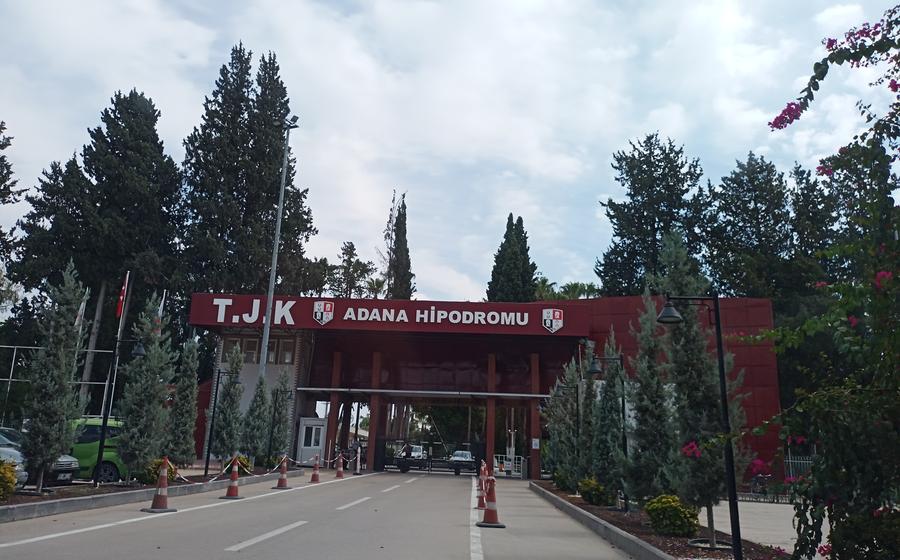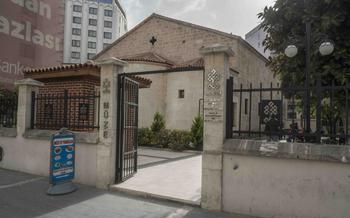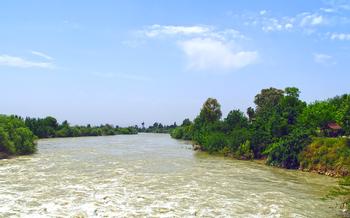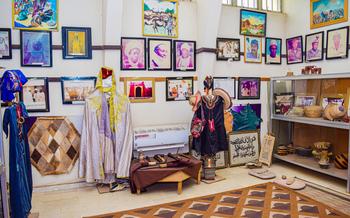
Yeşiloba Hippodrome
- The Antiquity of the City of Adana
- A Glimpse into the Past: The History of Yeşiloba Hippodrome
- Location and Accessibility: Finding the Yeşiloba Hippodrome
- Exploring the Ruins: What to See and Expect
- A Journey Through Time: The Hippodrome's Events
- The Excitement of Chariot Races: A Thrilling Spectacle
- The Brutal Reality of Gladiatorial Contests
- Beyond Chariot Races and Gladiatorial Contests: Other Events
- The Hippodrome's Impact on Adana's Culture and Society
- Preservation and Restoration: Efforts to Protect the Legacy
- Exploring the Surroundings: Hidden Gems Near the Hippodrome
- Planning Your Visit: Essential Tips for a Rewarding Experience
- Capturing the Essence: Photography and Videography Guidelines
- Educational Opportunities: Learning from the Past
- Insider Tip: Uncovering Hidden Secrets
The Antiquity of the City of Adana
Adana, a city in southern Turkey, boasts a rich and ancient history dating back to the Neolithic period. Situated on the fertile plains of the Seyhan River, Adana has been a strategic crossroads for trade and cultural exchange throughout the ages. Various civilizations, including the Hittites, Assyrians, Persians, Greeks, and Romans, have ruled the region, leaving behind a legacy of archaeological treasures and historical landmarks.
The city's strategic location made it a vital hub for trade routes connecting the Mediterranean Sea to the interior of Anatolia and beyond. This vibrant commercial activity contributed to the city's growth and prosperity, making it one of the most important cities in the ancient world.
Archaeological excavations in Adana have unearthed numerous artifacts and ruins that shed light on its rich past. Discoveries from these excavations provide valuable insights into the daily lives, customs, and traditions of the various civilizations that have called Adana home.
A Glimpse into the Past: The History of Yeşiloba Hippodrome
The Yeşiloba Hippodrome, a testament to the grandeur of ancient Adana, was constructed during the Roman Empire's reign over the region. The exact date of its construction remains uncertain, but historians believe it was built sometime in the 2nd or 3rd century AD. The hippodrome served as a significant venue for chariot races, a popular and exhilarating form of entertainment in Roman times.
The hippodrome's primary purpose was to host chariot races, which were not merely sporting events but also held cultural and political significance. The races showcased the prowess and wealth of the competing teams, and victories were celebrated with great fanfare. Beyond chariot races, the hippodrome also played a role in religious ceremonies and festivals, further solidifying its importance in the community.
Location and Accessibility: Finding the Yeşiloba Hippodrome
The Yeşiloba Hippodrome is situated in the heart of Adana, within easy reach of the city's main attractions. It is conveniently located in the central district, near the Seyhan River, making it easily accessible by various transportation modes. To reach the hippodrome, you can take advantage of the well-connected public transportation system. Several bus lines stop within walking distance of the site, making it a convenient option for budget travelers. Alternatively, taxis are readily available and offer a comfortable journey to the hippodrome. Once you arrive in the vicinity, you will find yourself surrounded by notable landmarks that serve as excellent navigational aids. The Grand Mosque of Adana, with its iconic minarets, stands as a prominent landmark. The Adana Ethnography Museum, showcasing the region's rich cultural heritage, is situated just a short walk away. These landmarks provide convenient reference points as you make your way to the Yeşiloba Hippodrome.
Exploring the Ruins: What to See and Expect
The Yeşiloba Hippodrome, despite being in ruins, offers a glimpse into the grandeur and spectacle of Roman entertainment. The site features several notable elements that speak to its former glory:
-
The Racecourse: The central feature of the hippodrome is the elongated racecourse, where chariot races took place. While much of the track has been eroded over time, the outline is still visible, allowing visitors to imagine the adrenaline-pumping races that once occurred here.
-
The Starting Gates: At one end of the racecourse, the remains of the starting gates can be seen. These intricate structures, once adorned with statues and inscriptions, served as the starting point for the chariot races, ensuring a fair and orderly beginning.
-
The Seating Stands: Although largely ruined, the remnants of the seating stands provide a sense of the scale and grandeur of the hippodrome. These stands, capable of accommodating thousands of spectators, were divided into sections based on social status, reflecting the hierarchical nature of Roman society.
-
Decorative Elements: Scattered throughout the ruins are fragments of decorative elements that once adorned the hippodrome. These include intricate carvings, sculptures, and inscriptions, providing glimpses of the artistic and architectural prowess of the Roman builders.
A Journey Through Time: The Hippodrome's Events
The Yeşiloba Hippodrome was not merely a sports arena but a bustling center of entertainment and spectacles. The most prominent events held here were chariot races, which originated in ancient Greece and became a beloved pastime throughout the Roman Empire. These races showcased teams of skilled charioteers competing for victory and glory.
The hippodrome's elongated track, known as the spina, divided the arena into two sections, allowing chariots to race in opposite directions. The charioteers, often representing different factions or cities, displayed remarkable skill and daring as they navigated the track, vying for position and avoiding collisions. The crowd's cheers and jeers reverberated through the air as they watched these thrilling contests unfold.
In addition to chariot races, the hippodrome also hosted gladiatorial contests, a brutal form of entertainment that tested the limits of human endurance and courage. Gladiators, often slaves, criminals, or prisoners of war, were forced to fight each other or wild animals for the amusement of the spectators. These contests were a stark reminder of the harsh realities of Roman society, where violence and death were commonplace.
Beyond these main events, the hippodrome served as a venue for a variety of other spectacles and performances. Artistic displays, such as acrobatics, juggling, and dancing, entertained the crowds. Religious ceremonies and festivals, honoring various deities, were also held within the hippodrome's sacred precincts. Political gatherings and announcements were made, demonstrating the hippodrome's role as a central hub of public life in ancient Adana.
The Excitement of Chariot Races: A Thrilling Spectacle
The Yeşiloba Hippodrome was a stage for one of the most exhilarating and dangerous sports of the Roman era: chariot racing. These races were not just a form of entertainment but also a fierce competition between teams representing different factions, or political groups, within the city. The atmosphere was electric, with the crowd cheering wildly for their favorite teams and jockeys.
The races typically consisted of seven laps around the track, and the chariots were pulled by four horses abreast. The jockeys, known as aurigas, stood in the chariots and used long whips to urge their horses on. The races were incredibly dangerous, with crashes and injuries a common occurrence.
The most famous teams in Adana were the Blues and the Greens, who had a long and bitter rivalry. The races often became more than just a sporting event, with political and social tensions spilling over into the arena. The outcome of the races could even have political consequences, with the winning team gaining favor and influence within the city.
The excitement and spectacle of the chariot races were a major part of life in Roman Adana. They were a chance for people from all walks of life to come together and experience the thrill of the race, cheer on their favorite team, and forget their troubles for a few hours.
The Brutal Reality of Gladiatorial Contests
Amidst the excitement of the hippodrome, there existed a darker side—the brutal and violent gladiatorial contests. These gruesome spectacles, originating in ancient Rome, found their way into the arenas of Adana's Yeşiloba Hippodrome. Gladiators, often slaves, criminals, or prisoners of war, were forced to fight to the death for the entertainment of the bloodthirsty crowd.
The gladiators were divided into different classes, each with its unique weapons and fighting style. There were heavily armored gladiators known as legionaries, nimble and agile gladiators called retiarii, and the iconic gladiators armed with a short sword and shield, known as secutores.
The contests were not merely about physical prowess but also about psychological manipulation. Gladiators were often pitted against wild beasts or other gladiators with different skill sets, creating an unpredictable and deadly spectacle. The crowd, baying for blood, cheered as the gladiators fought with ferocity and desperation.
The brutality of these contests was undeniable. Gladiators sustained severe injuries, and death was a common occurrence. The contests were a stark reminder of the harsh realities of ancient Roman society, where human life was often considered expendable for the sake of entertainment.
Beyond Chariot Races and Gladiatorial Contests: Other Events
The Yeşiloba Hippodrome was not solely dedicated to chariot races and gladiatorial contests. It served as a multi-purpose venue that hosted a diverse range of events that reflected the cultural and social fabric of Roman Adana. Artistic performances, cultural displays, religious ceremonies, festivals, and even political gatherings found their stage within the hippodrome's grand arena.
For those seeking cultural enrichment, the hippodrome offered a platform for theatrical productions, musical concerts, and dance performances. These events showcased the talents of local artists and traveling troupes, bringing together a diverse audience to celebrate the arts.
Religious festivals and ceremonies held at the hippodrome provided an opportunity for the community to come together and honor their deities. These events were often accompanied by processions, rituals, and sacrifices, creating a sacred atmosphere within the hippodrome's grounds.
Political gatherings and announcements were also held at the hippodrome, serving as a platform for officials to address the public and make important declarations. These events provided a means for citizens to engage with their leaders and stay informed about matters of governance.
The versatility of the Yeşiloba Hippodrome reflects the diverse interests and needs of Roman society. It was a place where entertainment, religion, politics, and culture intersected, creating a vibrant and multifaceted urban space.
The Hippodrome's Impact on Adana's Culture and Society
The Yeşiloba Hippodrome was not merely a venue for entertainment and spectacles; it played a pivotal role in shaping the cultural and social fabric of Adana. The events held at the hippodrome brought together people from all walks of life, creating a sense of community and shared identity. The excitement and rivalry of the chariot races fueled a spirit of competition and sportsmanship among the city's inhabitants. The gladiatorial contests, though brutal and violent, served as a form of public justice and a reminder of the power and authority of the Roman Empire.
Beyond its role as an entertainment center, the hippodrome was also a symbol of Roman power and influence. Its grand architecture and elaborate decorations reflected the wealth and prestige of the empire. The events held at the hippodrome were often used to display the might of the Roman military and to reinforce the loyalty of the conquered territories. The presence of the hippodrome in Adana served as a constant reminder of Roman authority and the city's integration into the vast network of the Roman Empire.
Preservation and Restoration: Efforts to Protect the Legacy
The Yeşiloba Hippodrome, a testament to Adana's rich history, has undergone significant preservation and restoration efforts to safeguard its legacy. Recognizing the importance of protecting this ancient site, local authorities and organizations have implemented various initiatives to ensure its longevity.
Conservation projects have focused on stabilizing the existing structures, conducting archaeological excavations to uncover new insights, and restoring architectural elements to their former glory. Through careful restoration techniques, the hippodrome's grandstands, seating areas, and decorative elements have been meticulously repaired, providing a glimpse into the grandeur of its past.
Despite these efforts, preserving the hippodrome remains a challenging endeavor. The site's exposure to natural elements, such as harsh weather conditions and earthquakes, poses ongoing threats to its integrity. Additionally, balancing the need for preservation with the desire to make the site accessible to visitors requires careful planning and management.
Despite these challenges, ongoing projects continue to enhance the hippodrome's preservation and accessibility. Visitors can explore the site through guided tours or self-guided walks, while informative signage and displays provide historical context and insights into the hippodrome's significance. Through these efforts, the Yeşiloba Hippodrome remains a living testament to Adana's rich cultural heritage, inviting visitors to step back in time and experience the grandeur of ancient Roman entertainment.
Exploring the Surroundings: Hidden Gems Near the Hippodrome
Beyond the captivating ruins of the Yeşiloba Hippodrome, Adana boasts a treasure trove of hidden gems waiting to be discovered. Just a stone's throw away, visitors can immerse themselves in the rich history and diverse culture of this vibrant city.
Historical Sites:
-
Adana Archaeological Museum: Delve into the region's fascinating past at this museum, home to an impressive collection of artifacts from ancient civilizations that once ruled Adana.
-
Misis Ancient City: Uncover the remnants of a once-flourishing Roman city, with its well-preserved ruins, including an impressive amphitheater and intricate mosaics.
Museums and Cultural Centers:
-
Adana Ethnography Museum: Gain insights into the local traditions and customs by exploring this museum's exhibits, showcasing traditional costumes, handicrafts, and everyday objects.
-
Atatürk Science and Culture Museum: Discover the life and achievements of Turkey's founding father, Mustafa Kemal Atatürk, through interactive displays and historical artifacts.
Culinary Delights:
-
Adana Kebabı: Savor the city's signature dish, a succulent skewer of grilled minced meat, served with aromatic spices and fresh vegetables.
-
Şırdan: Indulge in this local delicacy, consisting of stuffed lamb stomach, cooked to perfection and seasoned with a blend of herbs and spices.
Insider Tip:
- Hidden Courtyard Cafés: Discover charming hidden courtyards tucked away within the city's old quarters, offering a serene ambiance and delicious local cuisine.
Planning Your Visit: Essential Tips for a Rewarding Experience
To make the most of your visit to the Yeşiloba Hippodrome, careful planning is essential. For an optimal experience, consider visiting during the spring or fall, when the weather is pleasant and the crowds are smaller. Guided tours are available for a more comprehensive understanding of the site's history and significance. Alternatively, self-exploration allows you to wander at your own pace and capture the atmosphere of the ruins.
Essential facilities are available at the site, including restrooms, drinking water fountains, and a small café offering refreshments and snacks. Remember to wear comfortable shoes as you will be doing a lot of walking on uneven surfaces. Sun protection and a hat are recommended, especially during the summer months.
Before your visit, research and learn about the hippodrome's history, events, and significance. This will enhance your appreciation of the ruins and allow you to fully immerse yourself in the ancient world. Embrace the opportunity to explore, imagine, and connect with the past as you walk through the remnants of this once-vibrant arena.
Capturing the Essence: Photography and Videography Guidelines
The Yeşiloba Hippodrome offers a treasure trove of photographic opportunities for enthusiasts and professionals alike. With its sprawling ruins, intricate architectural details, and unique atmosphere, the site beckons photographers to capture its essence through their lenses.
-
Composition and Perspective: When photographing the hippodrome, experiment with different angles and perspectives to create dynamic compositions. Utilize leading lines, such as the rows of seats or the archways, to draw the viewer's eye into the image.
-
Lighting Conditions: Visit the hippodrome at different times of the day to take advantage of the changing light conditions. The golden hues of dawn and dusk can add a magical touch to your photographs.
-
Selective Focus: Use selective focus to highlight specific elements of the ruins, such as a weathered inscription or an ornate sculpture. This technique can create a sense of depth and draw attention to the details that make the hippodrome so captivating.
-
Drone Photography: If you have access to a drone, consider capturing aerial shots of the hippodrome. This perspective provides a bird's-eye view of the site, showcasing its scale and layout.
-
Respect and Etiquette: Remember to be respectful of the site and other visitors while taking photographs. Avoid using flash photography, as it can be disruptive to others. Also, be mindful of not obstructing the paths or views of other visitors.
By following these guidelines and unleashing your creativity, you can capture stunning images that will forever preserve the grandeur of the Yeşiloba Hippodrome.
Educational Opportunities: Learning from the Past
The Yeşiloba Hippodrome offers a wealth of educational opportunities for history enthusiasts, archaeologists, and anyone seeking to delve deeper into the past. Educational programs and workshops are organized regularly, providing insights into the history, architecture, and significance of the hippodrome. These programs often feature lectures by experts, guided tours with archaeologists, and hands-on activities that allow participants to engage with the site in a meaningful way.
Archaeological excavations and research projects are ongoing at the Yeşiloba Hippodrome, uncovering new artifacts and shedding light on the daily life and practices of the ancient Romans. Visitors can witness these excavations firsthand and learn about the latest discoveries from the archaeologists themselves.
Interactive exhibits and displays are also available at the site, providing an immersive and engaging experience for visitors of all ages. These exhibits use multimedia presentations, 3D models, and interactive displays to bring the history of the hippodrome to life, allowing visitors to visualize the chariot races, gladiatorial contests, and other events that took place within its walls.
Insider Tip: Uncovering Hidden Secrets
Beneath the ruins of the Yeşiloba Hippodrome lies a hidden gem that few visitors know about - a network of underground chambers and tunnels. These subterranean passages were once used for various purposes, including storage, escape routes, and even religious rituals. While not accessible to the public, the existence of these hidden chambers adds an air of mystery and intrigue to the site, hinting at the rich and complex history that lies beneath the surface.









